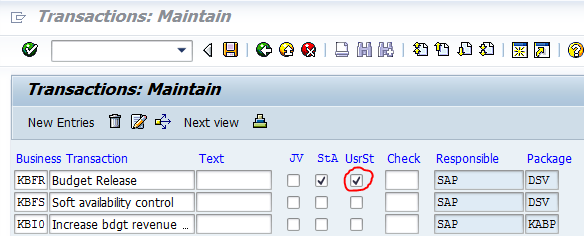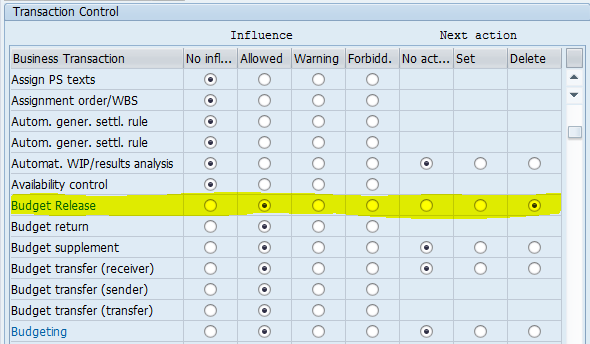
- SAP Community
- Products and Technology
- Enterprise Resource Planning
- ERP Blogs by Members
- Prevent release of WBS-element before Budgeting
- Subscribe to RSS Feed
- Mark as New
- Mark as Read
- Bookmark
- Subscribe
- Printer Friendly Page
- Report Inappropriate Content
The objective of this article is to guide you through SAP PS system customizing that prevents Release for WBS-elements before the budget allocation. Same approach can be applied to orders.
It is a very common business requirement to avoid any postings before the budget is assigned and availability control is activated. It can be achieved in few easy configuration steps with a user status profile.
Step 1: Create initial WBS user status
In a new or existing user status profile create a new initial user status. This initial user status should prevent everything except budgeting, and it can auto delete afterwards.
Let us assume I do not use any user status profiles with my WBS-elements yet, therefore I will create a new user status profile called ZWBS0001. Use the following IMG path:

Next click on New entry icon and populate the data as on the below screen:

Next double-click on the new profile record to drill down into setup of user statuses and maintain the following data:

Double-click the newly created NOBU status to browse into the overview of available operations, the system will display a pop-up window suggesting profile assignment to allowed object types:

I will select Yes option and maintain a check-mark for WBS-element:

Save the data, go back, drill-down again on the NOBU status and click on New entries button. This is a radio-button selection to allow or disallow different business transactions. I will keep budget related transactions active with status Delete option on Budgeting. Besides I will keep Release forbidden as shown on two next screens:


In case you are using availability control based on released budget you need to enable additional business transaction into the User Status list of managed business transactions that can influence the User Status.
Use transaction code BS32 and set a check mark for KBFR as shown on the below screen:

Next it will show up on the list of business transactions with additional radio-buttons and similar settings can be made:

Step 2: Assign the user Status Profile within Project Profile
Use the following IMG path:

Next I will assign the user status profile ZWBS0001 to the project profile 0000001 for the purpose of this example as shown on the below screen:

Now the customizing is completed and I can proceed with testing.
Step 3: Unit test
I will create a new project and a sample account assignment WBS-element with CJ01 transaction code. You can see that the initial user status NOBU is being automatically assigned:

Next I will try to Release the WBS-element using CJ02 transaction, the system will display an error message:

Finally I will go to transaction CJ30 to maintain original budget for the Project/WBS and next will display WBS master data in CJ03:

You can see that system status BUDG was raised by the system, while user status NOBU has disappeared.
This configuration setup is based on OSS Note 602588 - Availability control before budgeting and the note can provide additional support information as well as references to related OSS notes.
You are welcome to suggest any improvements to this article!
Thank you for reading,
Paulo
- SAP Managed Tags:
- PLM Project System (PS)
You must be a registered user to add a comment. If you've already registered, sign in. Otherwise, register and sign in.
-
"mm02"
1 -
A_PurchaseOrderItem additional fields
1 -
ABAP
1 -
ABAP Extensibility
1 -
ACCOSTRATE
1 -
ACDOCP
1 -
Adding your country in SPRO - Project Administration
1 -
Advance Return Management
1 -
AI and RPA in SAP Upgrades
1 -
Approval Workflows
1 -
ARM
1 -
ASN
1 -
Asset Management
1 -
Associations in CDS Views
1 -
auditlog
1 -
Authorization
1 -
Availability date
1 -
Azure Center for SAP Solutions
1 -
AzureSentinel
2 -
Bank
1 -
BAPI_SALESORDER_CREATEFROMDAT2
1 -
BRF+
1 -
BRFPLUS
1 -
Bundled Cloud Services
1 -
business participation
1 -
Business Processes
1 -
CAPM
1 -
Carbon
1 -
Cental Finance
1 -
CFIN
1 -
CFIN Document Splitting
1 -
Cloud ALM
1 -
Cloud Integration
1 -
condition contract management
1 -
Connection - The default connection string cannot be used.
1 -
Custom Table Creation
1 -
Customer Screen in Production Order
1 -
Data Quality Management
1 -
Date required
1 -
Decisions
1 -
desafios4hana
1 -
Developing with SAP Integration Suite
1 -
Direct Outbound Delivery
1 -
DMOVE2S4
1 -
EAM
1 -
EDI
2 -
EDI 850
1 -
EDI 856
1 -
EHS Product Structure
1 -
Emergency Access Management
1 -
Energy
1 -
EPC
1 -
Find
1 -
FINSSKF
1 -
Fiori
1 -
Flexible Workflow
1 -
Gas
1 -
Gen AI enabled SAP Upgrades
1 -
General
1 -
generate_xlsx_file
1 -
Getting Started
1 -
HomogeneousDMO
1 -
IDOC
2 -
Integration
1 -
Learning Content
2 -
LogicApps
2 -
low touchproject
1 -
Maintenance
1 -
management
1 -
Material creation
1 -
Material Management
1 -
MD04
1 -
MD61
1 -
methodology
1 -
Microsoft
2 -
MicrosoftSentinel
2 -
Migration
1 -
MRP
1 -
MS Teams
2 -
MT940
1 -
Newcomer
1 -
Notifications
1 -
Oil
1 -
open connectors
1 -
Order Change Log
1 -
ORDERS
2 -
OSS Note 390635
1 -
outbound delivery
1 -
outsourcing
1 -
PCE
1 -
Permit to Work
1 -
PIR Consumption Mode
1 -
PIR's
1 -
PIRs
1 -
PIRs Consumption
1 -
PIRs Reduction
1 -
Plan Independent Requirement
1 -
Premium Plus
1 -
pricing
1 -
Primavera P6
1 -
Process Excellence
1 -
Process Management
1 -
Process Order Change Log
1 -
Process purchase requisitions
1 -
Product Information
1 -
Production Order Change Log
1 -
Purchase requisition
1 -
Purchasing Lead Time
1 -
Redwood for SAP Job execution Setup
1 -
RISE with SAP
1 -
RisewithSAP
1 -
Rizing
1 -
S4 Cost Center Planning
1 -
S4 HANA
1 -
S4HANA
3 -
Sales and Distribution
1 -
Sales Commission
1 -
sales order
1 -
SAP
2 -
SAP Best Practices
1 -
SAP Build
1 -
SAP Build apps
1 -
SAP Cloud ALM
1 -
SAP Data Quality Management
1 -
SAP Maintenance resource scheduling
2 -
SAP Note 390635
1 -
SAP S4HANA
2 -
SAP S4HANA Cloud private edition
1 -
SAP Upgrade Automation
1 -
SAP WCM
1 -
SAP Work Clearance Management
1 -
Schedule Agreement
1 -
SDM
1 -
security
2 -
Settlement Management
1 -
soar
2 -
SSIS
1 -
SU01
1 -
SUM2.0SP17
1 -
SUMDMO
1 -
Teams
2 -
User Administration
1 -
User Participation
1 -
Utilities
1 -
va01
1 -
vendor
1 -
vl01n
1 -
vl02n
1 -
WCM
1 -
X12 850
1 -
xlsx_file_abap
1 -
YTD|MTD|QTD in CDs views using Date Function
1
- « Previous
- Next »
- Public Sector Management in SAP S/4HANA Cloud Public Edition 2402 in Enterprise Resource Planning Blogs by SAP
- SAP Central Finance - All blogs in one page in Enterprise Resource Planning Blogs by Members
- Financial Planning with Universal Parallel Accounting in SAP S/4HANA 2022 in Enterprise Resource Planning Blogs by SAP
- Release Highlights for Higher Education & Research S/4HANA Cloud, Public Edition 2308 in Enterprise Resource Planning Blogs by SAP
- Fund management: How to reduce released budget in Enterprise Resource Planning Q&A
| User | Count |
|---|---|
| 2 | |
| 2 | |
| 2 | |
| 2 | |
| 2 | |
| 1 | |
| 1 | |
| 1 | |
| 1 | |
| 1 |